#C-UAS (Counter-Unmanned Aircraft System)
Explore tagged Tumblr posts
Text
Thermal Imaging Market to be Worth $7.8 Billion by 2032
Meticulous Research®—a leading global market research company, published a research report titled, ‘Thermal Imaging Market by Type (Handheld Cameras, Fixed Cameras, Scopes, Modules), Technology (Cooled, Uncooled), Wavelength (SWIR, MWIR, LWIR), Application (Security & Surveillance) - Global Forecast to 2032’
According to the latest publication from Meticulous Research®, the thermal imaging market is expected to reach $7.8 billion by 2032, at a CAGR of 7.2% from 2025 to 2032. This market’s growth is attributed to several factors, such as the growing need for surveillance & security solutions and the increasing utilization of thermal imaging in manufacturing and industrial settings. Additionally, the surge in demand for thermal imaging in healthcare, growing military & defense expenditure in advanced surveillance technologies, and rising unmanned aerial vehicles (UAVs) are expected to create market growth opportunities. However, the availability of alternative imaging technologies, such as visible light cameras & radar systems, may restrain the growth of this market.
On the other hand, the high cost of thermal imaging devices is a major challenge for the players operating in this market.
The global thermal imaging market is segmented by type, technology, wavelength, and application. This study also evaluates end-user industry competitors and analyzes the market at the region/country level.
Based on type, the thermal imaging market is broadly segmented into handheld/portable cameras, fixed/mounted cameras, scopes & eyewear, and modules. In 2025, the portable or handheld cameras segment is expected to account for the largest share, over 55.0%. This segment's large market share is attributed to its features, such as ease of use and portability, and the growing use of portable or handheld cameras for field inspection & maintenance and emergency and rescue operations.
However, the fixed/mounted cameras segment is expected to register the highest CAGR during the forecast period. This segment’s growth is driven by its ability to provide continuous, high-precision, real-time monitoring of critical infrastructure without the need for manual intervention, to withstand harsh environmental conditions, and its increasing demand for fixed thermal cameras for integrating with automated security and monitoring systems.
Based on technology, the thermal imaging market is segmented into cooled thermal imaging and uncooled thermal imaging. In 2025, the cooled thermal imaging segment is expected to account for a larger share of over 64.0% of the thermal imaging market. This segment’s large market share is due to its sensitivity, high accuracy, long-range detection, and image resolution, which allows for the detection of minute temperature differences and the capture of detailed thermal images and increasing use of cooled thermal imaging for extreme environmental conditions, such as high-temperature industrial environments or cold regions.
However, the uncooled thermal imaging segment is expected to register the highest CAGR during the forecast period. This segment’s growth is driven by its features, including cost-effectiveness, ease of maintenance, reduced operational costs, and growing demand for uncooled thermal imaging products in applications such as building diagnostics, wildlife monitoring, emergency response, law enforcement, and temporary monitoring needs in various scenarios.
Based on wavelength, the thermal imaging market is segmented into shortwave infrared (SWIR), mid-wave infrared (MWIR), and longwave infrared (LWIR). In 2025, the LWIR segment is expected to account for the largest share of over 49.0% of the thermal imaging market. The growing use of LWIR cameras in environmental monitoring, advanced driver assistance systems (ADAS), security and surveillance, and the need to detect thermal radiation emitted by objects across various industries are the main causes of this segment's large market share. Other factors include the segment's ability to provide non-contact temperature measurement for monitoring high-temperature processes and equipment, and its cost-effectiveness in comparison to MWIR and SWIR systems.
However, the SWIR segment is expected to register the highest CAGR during the forecast period. This growth is driven by its superior image contrast and detail, enhanced capability to ensure clear visibility in challenging environmental conditions, including smoke, fog, and haze, and growing demand for SWIR technology in medical diagnostics for non-invasive imaging.
Based on application, the thermal imaging market is segmented into aerospace & defense, security & surveillance, building & construction, personal vision systems, healthcare & medical diagnostics, energy & utilities, agriculture, research & development, search & rescue operations, marine systems, and other applications. In 2025, the security & surveillance segment is expected to account for the largest share of over 41.0% of the thermal imaging market. The growing need for improved surveillance capabilities, such as visibility in low light and obscured conditions, the growing use of thermal imaging to improve perimeter security for securing sensitive facilities and high-profile events, and the growing integration of thermal cameras into smart security systems to the overall effectiveness of security measures are all factors contributing to this segment's large market share.
However, the healthcare & medical diagnostics segment is expected to register the highest CAGR during the forecast period. This growth is being driven by an increase in demand for thermal imaging technology owing to its non-invasive nature for early disease detection by identifying abnormal heat patterns associated with conditions such as breast cancer, vascular disorders, and inflammation, and an increase in the use of thermal imaging for fever screening in public areas and in veterinary medicine to diagnose and monitor health conditions in animals.
Based on geography, the thermal imaging market is segmented into North America, Europe, Asia-Pacific, Latin America, and the Middle East & Africa. In 2025, North America is expected to account for the largest share of over 36.0% of the thermal imaging market.
North America's significant market share can be attributed to several key factors, including rising concerns over terrorism, crime, and public safety, increasing deployment of thermal imaging in large-scale surveillance applications such as city-wide monitoring or border control, increasing technological advancements in thermal imaging, high investments in advanced technologies for military and defense applications, and growing focus on advancing medical tools for non-invasive diagnostics and early disease detection.
Moreover, Asia-Pacific is expected to register the highest CAGR of over 8.5% during the forecast period.
Key Players:
The key players operating in the thermal imaging market are Teledyne FLIR LLC (U.S.) (a subsidiary of Teledyne Technologies Incorporated (U.S.)), Fluke Corporation (U.S.), L3Harris Technologies, Inc. (U.S.), Leonardo S.p.A. (Italy), Axis Communications AB (Sweden), BAE Systems plc (U.K.), RTX Corporation (U.S.), Lockheed Martin Corporation (U.S.), Testo SE & Co. KGaA (Germany), Thales Group (France), Seek Thermal, Inc. (U.S.), Exosens (France), Honeywell International Inc. (U.S.), Trijicon, Inc. (U.S.), Cantronic Systems, Inc. (U.S.), Safran Group (France), Zhejiang Dali Technology Co., Ltd. (China), HT Italia S.r.l. (Italy), Thermoteknix Systems Ltd. (U.K.), and Bullard (U.S.).
Download Sample Report Here @ https://www.meticulousresearch.com/download-sample-report/cp_id=5978
Key questions answered in the report-
Which are the high-growth market segments based on type, technology, wavelength, application, and geography?
What was the historical market for the thermal imaging market?
What are the market forecasts and estimates for the period 2025–2032?
What are the major drivers, restraints, opportunities, and challenges in the thermal imaging market?
Who are the major players, and what shares do they hold in the thermal imaging market?
What is the competitive landscape in the thermal imaging market?
What are the recent developments in the thermal imaging market?
What do the major players adopt the different strategies in the thermal imaging market?
What are the key geographic trends, and which are the high-growth countries?
Who are the local emerging players in the global thermal imaging market, and how do they compete with the other players?
Contact Us: Meticulous Research® Email- [email protected] Contact Sales- +1-646-781-8004 Connect with us on LinkedIn- https://www.linkedin.com/company/meticulous-research
#Thermal Imaging Market#Thermal Image#Night Vision#Thermogram#Security & Surveillance#Monitoring & Inspection#Fire Fighting#Personal Vision Systems#Vehicle Targeting#Counter-Unmanned Aircraft Systems (C-UAS)#Maritime & Coastal Surveillance#Search & Rescue Operation#Space Exploration Thermal Mapping#Handheld/Portable Cameras#Fixed/Mounted Cameras#Thermal Scopes#Military Targeting Systems#Perimeter Surveillance
0 notes
Text
Thermal Imaging Market to be Worth $7.8 Billion by 2032
Meticulous Research®—a leading global market research company, published a research report titled, ‘Thermal Imaging Market by Type (Handheld Cameras, Fixed Cameras, Scopes, Modules), Technology (Cooled, Uncooled), Wavelength (SWIR, MWIR, LWIR), Application (Security & Surveillance) - Global Forecast to 2032’
According to the latest publication from Meticulous Research®, the thermal imaging market is expected to reach $7.8 billion by 2032, at a CAGR of 7.2% from 2025 to 2032. This market’s growth is attributed to several factors, such as the growing need for surveillance & security solutions and the increasing utilization of thermal imaging in manufacturing and industrial settings. Additionally, the surge in demand for thermal imaging in healthcare, growing military & defense expenditure in advanced surveillance technologies, and rising unmanned aerial vehicles (UAVs) are expected to create market growth opportunities. However, the availability of alternative imaging technologies, such as visible light cameras & radar systems, may restrain the growth of this market.
On the other hand, the high cost of thermal imaging devices is a major challenge for the players operating in this market.
The global thermal imaging market is segmented by type, technology, wavelength, and application. This study also evaluates end-user industry competitors and analyzes the market at the region/country level.
Download Sample Report Here @ https://www.meticulousresearch.com/download-sample-report/cp_id=5978
Based on type, the thermal imaging market is broadly segmented into handheld/portable cameras, fixed/mounted cameras, scopes & eyewear, and modules. In 2025, the portable or handheld cameras segment is expected to account for the largest share, over 55.0%. This segment's large market share is attributed to its features, such as ease of use and portability, and the growing use of portable or handheld cameras for field inspection & maintenance and emergency and rescue operations.
However, the fixed/mounted cameras segment is expected to register the highest CAGR during the forecast period. This segment’s growth is driven by its ability to provide continuous, high-precision, real-time monitoring of critical infrastructure without the need for manual intervention, to withstand harsh environmental conditions, and its increasing demand for fixed thermal cameras for integrating with automated security and monitoring systems.
Based on technology, the thermal imaging market is segmented into cooled thermal imaging and uncooled thermal imaging. In 2025, the cooled thermal imaging segment is expected to account for a larger share of over 64.0% of the thermal imaging market. This segment’s large market share is due to its sensitivity, high accuracy, long-range detection, and image resolution, which allows for the detection of minute temperature differences and the capture of detailed thermal images and increasing use of cooled thermal imaging for extreme environmental conditions, such as high-temperature industrial environments or cold regions.
However, the uncooled thermal imaging segment is expected to register the highest CAGR during the forecast period. This segment’s growth is driven by its features, including cost-effectiveness, ease of maintenance, reduced operational costs, and growing demand for uncooled thermal imaging products in applications such as building diagnostics, wildlife monitoring, emergency response, law enforcement, and temporary monitoring needs in various scenarios.
Based on wavelength, the thermal imaging market is segmented into shortwave infrared (SWIR), mid-wave infrared (MWIR), and longwave infrared (LWIR). In 2025, the LWIR segment is expected to account for the largest share of over 49.0% of the thermal imaging market. The growing use of LWIR cameras in environmental monitoring, advanced driver assistance systems (ADAS), security and surveillance, and the need to detect thermal radiation emitted by objects across various industries are the main causes of this segment's large market share. Other factors include the segment's ability to provide non-contact temperature measurement for monitoring high-temperature processes and equipment, and its cost-effectiveness in comparison to MWIR and SWIR systems.
However, the SWIR segment is expected to register the highest CAGR during the forecast period. This growth is driven by its superior image contrast and detail, enhanced capability to ensure clear visibility in challenging environmental conditions, including smoke, fog, and haze, and growing demand for SWIR technology in medical diagnostics for non-invasive imaging.
Based on application, the thermal imaging market is segmented into aerospace & defense, security & surveillance, building & construction, personal vision systems, healthcare & medical diagnostics, energy & utilities, agriculture, research & development, search & rescue operations, marine systems, and other applications. In 2025, the security & surveillance segment is expected to account for the largest share of over 41.0% of the thermal imaging market. The growing need for improved surveillance capabilities, such as visibility in low light and obscured conditions, the growing use of thermal imaging to improve perimeter security for securing sensitive facilities and high-profile events, and the growing integration of thermal cameras into smart security systems to the overall effectiveness of security measures are all factors contributing to this segment's large market share.
However, the healthcare & medical diagnostics segment is expected to register the highest CAGR during the forecast period. This growth is being driven by an increase in demand for thermal imaging technology owing to its non-invasive nature for early disease detection by identifying abnormal heat patterns associated with conditions such as breast cancer, vascular disorders, and inflammation, and an increase in the use of thermal imaging for fever screening in public areas and in veterinary medicine to diagnose and monitor health conditions in animals.
Based on geography, the thermal imaging market is segmented into North America, Europe, Asia-Pacific, Latin America, and the Middle East & Africa. In 2025, North America is expected to account for the largest share of over 36.0% of the thermal imaging market.
North America's significant market share can be attributed to several key factors, including rising concerns over terrorism, crime, and public safety, increasing deployment of thermal imaging in large-scale surveillance applications such as city-wide monitoring or border control, increasing technological advancements in thermal imaging, high investments in advanced technologies for military and defense applications, and growing focus on advancing medical tools for non-invasive diagnostics and early disease detection.
Moreover, Asia-Pacific is expected to register the highest CAGR of over 8.5% during the forecast period.
Key Players:
The key players operating in the thermal imaging market are Teledyne FLIR LLC (U.S.) (a subsidiary of Teledyne Technologies Incorporated (U.S.)), Fluke Corporation (U.S.), L3Harris Technologies, Inc. (U.S.), Leonardo S.p.A. (Italy), Axis Communications AB (Sweden), BAE Systems plc (U.K.), RTX Corporation (U.S.), Lockheed Martin Corporation (U.S.), Testo SE & Co. KGaA (Germany), Thales Group (France), Seek Thermal, Inc. (U.S.), Exosens (France), Honeywell International Inc. (U.S.), Trijicon, Inc. (U.S.), Cantronic Systems, Inc. (U.S.), Safran Group (France), Zhejiang Dali Technology Co., Ltd. (China), HT Italia S.r.l. (Italy), Thermoteknix Systems Ltd. (U.K.), and Bullard (U.S.).
Complete Report Here : https://www.meticulousresearch.com/product/thermal-imaging-market-5978
Key questions answered in the report-
Which are the high-growth market segments based on type, technology, wavelength, application, and geography?
What was the historical market for the thermal imaging market?
What are the market forecasts and estimates for the period 2025–2032?
What are the major drivers, restraints, opportunities, and challenges in the thermal imaging market?
Who are the major players, and what shares do they hold in the thermal imaging market?
What is the competitive landscape in the thermal imaging market?
What are the recent developments in the thermal imaging market?
What do the major players adopt the different strategies in the thermal imaging market?
What are the key geographic trends, and which are the high-growth countries?
Who are the local emerging players in the global thermal imaging market, and how do they compete with the other players?
Contact Us: Meticulous Research® Email- [email protected] Contact Sales- +1-646-781-8004 Connect with us on LinkedIn- https://www.linkedin.com/company/meticulous-research
#Thermal Imaging Market#Thermal Image#Night Vision#Thermogram#Security & Surveillance#Monitoring & Inspection#Fire Fighting#Personal Vision Systems#Vehicle Targeting#Counter-Unmanned Aircraft Systems (C-UAS)#Maritime & Coastal Surveillance#Search & Rescue Operation#Space Exploration Thermal Mapping#Handheld/Portable Cameras#Fixed/Mounted Cameras#Thermal Scopes#Military Targeting Systems#Perimeter Surveillance
0 notes
Text
Dronebuster: Countering the Growing Threat of Unmanned Aerial Vehicles
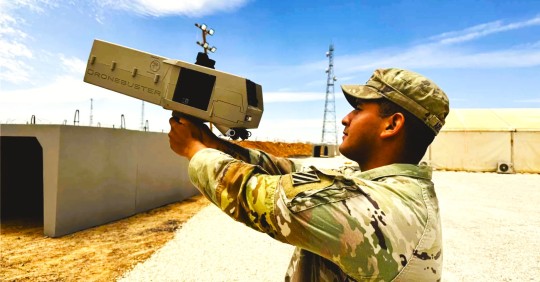
The recent Eager Lion 2024 military exercise in Jordan served as a crucial platform for the U.S. Army to showcase its advanced Dronebuster technology. This innovative system highlights the growing importance of counter-drone measures as unmanned aerial vehicles (UAVs), commonly known as drones, continue to surge globally.
#Dronebuster#Counter-drone#Unmanned Aerial Vehicle (UAV)#C-UAS (Counter-Unmanned Aircraft System)#Eager Lion Military Exercise#BLOS Vs LOS#Reconnaissance drone#U.S. Army#U.S. Department of Defense#NATO#drone#drones uav#military technology#military#military aircraft
0 notes
Text

U.S. F-16 Fighters Shot Down Drones with Laser-Guided Rockets in Combat
F-16 APKWS shoot drones
The U.S. Air Force has officially employed for the first time laser-guided 70mm rockets in the air-to-air role during operations in the Red Sea over the course of 2024. The Advanced Precision Kill Weapon System II (APKWS II) guided-rockets were deployed from F-16 Viper multirole fighter jets to engage hostile drones launched by the Houthis, the Iranian-backed Yemeni militia.
The U.S. Air Force confirmed that F-16 fightes used Advanced Precision Kill Weapon System 70mm guided rockets in the air-to-air role in combat to shoot down Houthi drones.The APKWS IIU.S. Operations in the Red Sea against the Houthis
The U.S. Air Force has first announced back in 2019 that the APKWS II, originally developed as a low-cost air-to-ground precision munition, had been tested successfully in the air-to-air role, but until now no operational use of the weapon in this role has been disclosed. The details of the combat debut of the APKWS II in this new role are still scarce, with no knowledge of how many guided rockets were employed, how many Houthi drones have been shot down with the weapon, and the exact timeline of the engagements.
A U.S. official told to The War Zone few days ago that the APWKS II air-to-air capability was first employed last year “as one of many options for countering the Houthi UAS threat.” The official added that “It is a lower-cost option compared to the AIM-9X. That lower cost is one of the benefits of using it.”
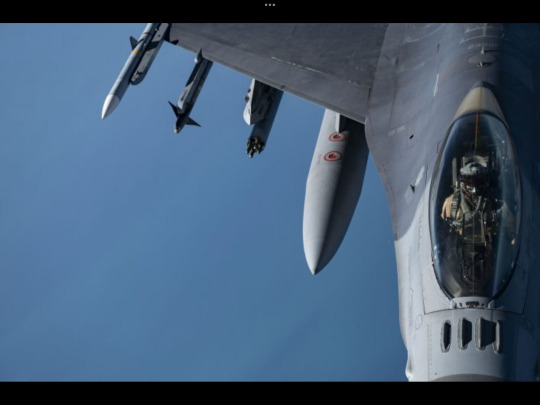
A U.S. Air Force F-16 Fighting Falcon is refueled over the U.S. Central Command area of responsibility Dec. 17, 2024. [Author’s note: : the aircraft is armed with a 7-round rocket launcher.] (U.S. Air Force photo)
The APKWS II
The AGR-20 Advanced Precision Kill Weapon System II (APKWS II) is a conversion of the Hydra 70 unguided rockets which adds a laser guidance kit to the baseline weapon, turning it into a precision-guided munition (PGM). The Hydra 70 is itself derived from a previous weapon, the 2.75-inch (70 mm) Mk 4/Mk 40 Folding-Fin Aerial Rocket (FFAR) of the late 1940s, a system widely employed in the Korean and Vietnam wars.
By adding a guidance section to a cheap rocket (inserted in the middle of the rocket, between the 10-pound high-explosive warhead at the front and the Mk66 Mod 4 rocket motor at the rear), the U.S. Air Force has therefore been able to obtain low-cost smart munitions that can be used in the air-to-ground role. These are particularly useful when the full warhead of larger bombs (like JDAM) and missiles (like the AGM-65 Maverick or AGM-114 Hellfire anti-tank missiles) is not needed to obtain the desired effects or not suitable due to the danger of collateral damages.
The guidance section of the APKWS includes four foldable wings with wing-mounted laser seeker collection optics with a wide field of view which enable to engage both moving and stationary targets. BAE Systems, which produces the weapon, says that “no modifications are required to the rocket, firing platform or fire control system,” with the only known modification being a longer variant of the LAU-131/A 7-round rocket launcher normally employed by the U.S. Air Force, called the LAU-131 A/A (the Navy uses the AGR-20 with the similar LAU-68 F/A).
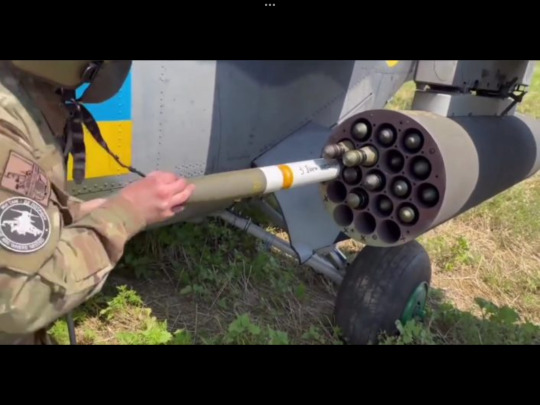
Ukrainian airman loading an American-made Hydra 70 unguided rocket into a rocket pod of a Czech-delivered Mil Mi-24V helicopter. (Image credit: Screenshot from X video)
The APKWS is also being used in a novel surface-to-air mode as a Counter-Unmanned Aircraft Systems (C-UAS) to engage low-flying, slow and cheap drones. Specifically, the weapon has been included in the Electronic Advanced Ground Launcher System (EAGLS) employed by the U.S. military in the Middle East and the U.S.-supplied VAMPIRE (Vehicle-Agnostic Modular Palletized ISR Rocket Equipment) used by Ukraine to counter Russian drones.
The U.S. Navy also announced in late 2023 that it was about to deliver a new proximity-fused warhead for APKWS II rockets, optimized for use against drones, albeit developed ostensibly for the surface-to-air role. However, further developing an air-to-air capability out of these older rockets is another impressive feat for the U.S. Air Force, that has now the possibility to engage targets at a very small fraction of the cost of other existing missiles.
While a current beyond visual range radar-guided AIM-120 Advanced Medium Range Air-to-Air Missile (AMRAAM) is priced at more than $1 million each and an AIM-9X Sidewinder Block II has a price tag of around $420,000, the guidance section of an APKWS II only costs around $15,000, with the full APKWS II round only costing a few thousand dollars more (to include the warhead and the motor).
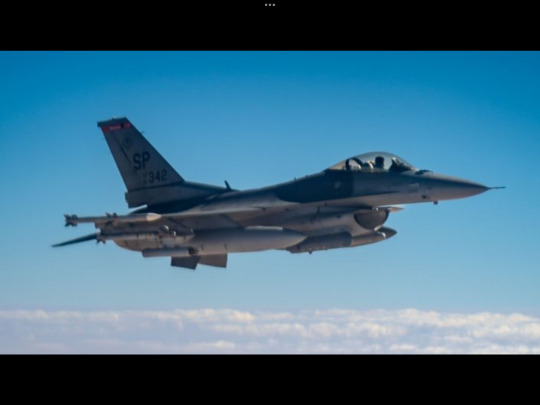
A U.S. Air Force F-16 Fighting Falcon flies a routine presence patrol mission over the U.S. Central Command area of responsibility, Jan. 25, 2025. [Author’s note: : the aircraft is armed with a 7-round rocket launcher.] (U.S. Air Force photo by Staff Sgt. Jackson Manske)
The low cost of the APKWS II comes with some restrictions, as the weapon is shorter ranged than the current USAF missiles, and the warhead is also smaller. However, against slow and cheap targets like drones, the AGR-20 can provide the Air Force with a highly cost-effective weapon.
Moreover, the APKWS II can provide American jets with deeper magazines for air-to-air munitions, as they can be carried in a 7-shot rocket pod on a single hardpoint that could otherwise take only a single AIM-9X or AIM-120 missile. The F-16 is also able to carry two LAU-131/As with the standard 70 mm unguided rockets on each pylon by using a triple ejector rack, although it is unclear if this capability is also available for the LAU-131A/A with the AGR-20.
This feature could come in hand while facing swarm or saturation attacks from enemy drones, a tactic that has already been used by Russia in their aggression of Ukraine, by Iran in their attacks on Israel and sometimes on a smaller scale even by the Houthis. The high cost of the interceptors against these cheap targets and the magazine size of the launching platforms have been two of the main concerns highlighted by forces countering these attacks.
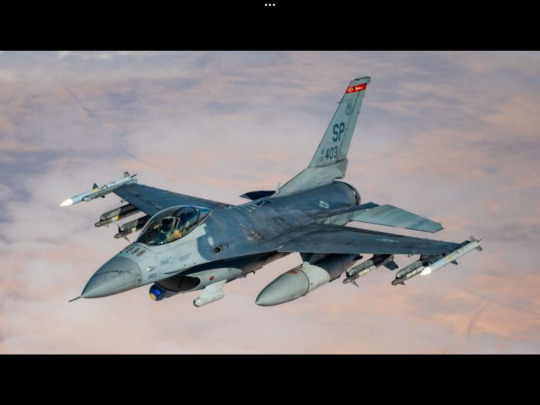
A U.S. Air Force F-16 Fighting Falcon flies a routine presence patrol mission over the U.S. Central Command area of responsibility, Jan. 25, 2025. [Author’s note: : the aircraft is loaded with a mix of AIM-120C, AIM-9M and AIM-9X missiles and accompanies the fighter armed with the APKWS] (U.S. Air Force photo by Staff Sgt. Jackson Manske)
U.S. Operations in the Red Sea against the Houthis
The U.S. military has been involved since late 2023 in operations with a multi-national coalition in the Red Sea, in the Gulf of Aden and in the area of the Bab el-Mandeb strait against the Iranian-backed Houthi militia operating out of Yemen. The Houthis started attacks on civilian shipping in the area after the terrorist attack of Hamas on Israel of Oct. 7, 2023.
To support Hamas, Houthis employed both aerial and naval drones, in addition to missile attacks, against shipping routes while also launching sporadic long-range drone and ballistic missile attacks on Israel. After the UN Security Council adopted Resolution 2722 in January 2024, condemning the Houthi attacks and reaffirming the freedom of navigation, the United States launched Operation Prosperity Guardian, aimed at protecting civilian shipping and reducing the Houthi threat, with the first airstrike against Houthis dating back to Jan. 12, 2024.
Over the course of one year, the warships and aircraft involved in Operation Prosperity Guardian have engaged multiple times Houthi targets, including land strikes to remove military capabilities from the terrorist group, and engagements to shoot down drones and missiles launched from Yemen.

The Carrier Air Wing 3, aboard the aircraft carrier USS Eisenhower (CVN-69), logged 14,000 sorties, 32,000 flight hours and 15,000 arrested landings during a lengthy deployment in the Red Sea, while its F/A-18E/F Super Hornets and E/A-18G Growlers shot more than 60 air-to-air missiles. Operation Prosperity Guardian also included the first long-range operational use of B-2 stealth bombers against Yemen, with the stealth bombers flying all the way from their home base at Whiteman Air Force Base in Missouri, and the combat debut of the F-35C carrier-based stealth fighter jets.
Interestingly, the U.S. Navy recently announced that an MH-60R Seahawk helicopter, an upgraded variant of the original UH-60 Black Hawk developed for naval use, has been involved in the shoot-down of a Houthi drone, but it is unclear what weapon was involved and when this happened. Probable candidates for the achievement are however restricted to only a few weapon system, including the AGM-114 Hellfire missile, the very AGR-20 Advanced Precision Kill Weapon System (APKWS) also used by U.S. Air Force’s F-16s, or on-board machine guns.
MH-60R shoots down drone
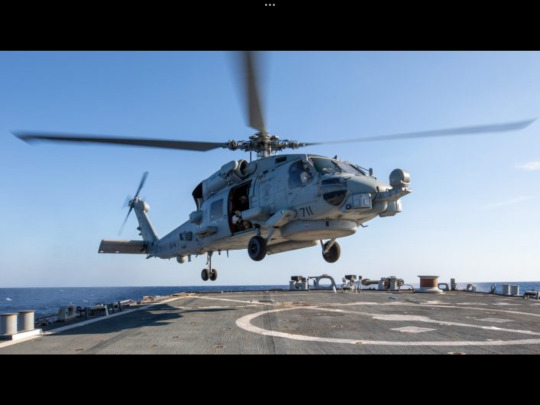
An MH-60R Sea Hawk prepares to land on the flight deck aboard the Arleigh Burke-class guided-missile destroyer USS Cole (DDG 67) in the U.S. Central Command area of responsibility. (Image credit: U.S. Navy Seaman Mark Pena)
@TheAviationist .com
14 notes
·
View notes
Text
'Threat detectors': Australia issues first batch of counter-UAS system contracts
Australian Army Corporal Patrick Flanagan operates the AIM Defence Counter-UAS Directed Energy Weapons System during a demonstration at the Puckapunyal Military Area, Australia. (Credit: CPL Jacob Joseph/Australian Department of Defence) MELBOURNE — Less than a year after inviting tenders for a program to rapidly acquire a suite of counter-Unmanned Aircraft Systems (c-UAS) capabilities,…
0 notes
Text

Santiago de Cali July 23 2025. Oscar Fredy Posso Vitali. Today More News.
Autónomous Drones Take Flight at NATO - Backed Competition.
From 6 to 10 July Four Teams of Seven Researchers and Profesors of Universities in The Netherlands, United States and Austria Challenged Each Other as the Huntsville UAS Unmaned Aircraft System and C-UAS Counter UAS Test Range in Alabama as Part of Competition Supported by the NATO Science for Peace and Security Programme.
Security Council Live: Debate on The Situation in The Middle East. The Security Council Meets Today in Quarterly Open Debate About Situation Middle East Focussed in Worsening Crisis in Gaza, Ravaged Enclave Where Food Entry and Distribution Remain Severely Restricted, Malnutrition Rising, While Fuel and Shelter Supplies Critically Scarce.
World Court Issues Advisory Opinión on Climate Change. The International Court of Justice ICJ in The Hague, Issued Advisory Opinión on Obligations of States in Respect of Climate Change, Readout by the Chair Court, Judge Iwasawa Yuji Today.
Colombian Govern Will Install Institutional Table With Congress and High Courts About New Rule Submmit.
Petro's Government Analyzes Exit Some Ministers. The Ministers Health, Environment and Equality. Man Falldown on Soil Since 11th Floor Building in Barranquilla.
Plane in Italy Crashing Against a Roadway: Two Deaths. USA Warns Half Percent Recuts Budget for Colombia in 2026. The Pope Leo Thinking in His Return at Vatican After Vacations in Castelgandolfo. Russia and Ukraine Retake Peace Negotiations in Istambul City of Turkey. Trump Announces Japan Trade Deal 15 Percent Tariffs. 38 People Hunger Dying in Gaza. Irán Fully Ready to Strike Israel Again and Not Detain Uranium Enrichment. More Than 100 ONG Warning Massive Famine in Gaza. Donald Trump Acussing Barack Obama by Trying Coup. Pope Leo: No Needful Luxuries to Buy, is Needful a Willing Heart to Make God's Volition.
0 notes
Text
NQDefense Counter-Unmanned Aerial Systems: Total UAV Security
The rise of drone technology demands robust security measures, and NQDefense Counter-Unmanned Aerial Systems deliver comprehensive solutions. Our C-UAS technology employs radar, RF disruption, and AI-enhanced tracking to counter UAV threats. Whether for defense, law enforcement, or commercial security, NQDefense Counter-Unmanned Aerial Systems provide unmatched drone mitigation capabilities. Prevent unauthorized surveillance, smuggling, and aerial attacks with cutting-edge C-UAS technology. Trust NQDefense to safeguard your airspace with precision and efficiency.
Know more: https://www.nqdefense.com/understanding-the-need-for-counter-unmanned-aircraft-systems/
#NQDefense #CounterUnmannedAerialSystems
0 notes
Text
One troubling finding from the bipartisan Senate investigation was how technical issues downed Secret Service drones during the July 13 rally in Butler, Pennsylvania.
The agent responsible for overseeing the Counter Unmanned Aircraft Systems (C-UAS) called a toll free 888 tech support hotline 'to start troubleshooting with the company.' There were no backups.
It took several hours to get the drones back up and running – and the agent responsible for the drone operations only had three months of experience with the equipment.
0 notes
Text
Revolutionising Real-Time Drone Threat Detection and Mitigation with DroneShield’s C-UAS Solutions
The surge in unmanned aerial systems (UAS) activity across various landscapes has heightened security concerns. The presence of these drones, often with unknown motives, classifies them as potential threats, emphasising the need for robust counterdrone protection measures.
DroneShield, a leader in optical detection and tracking, has partnered with the University of Technology Sydney to unveil their award-winning AI engine, DroneOptID. This state-of-the-art software harnesses the power of Computer Vision technology to provide real-time detection, identification, and tracking of drone targets, setting a new standard in counterdrone defense.
Counterdrone Protection to Protect Crowded Spaces
UAS frequently targets densely populated areas such as stadiums, concert venues, public markets, and other crowded spaces. To safeguard these high-risk environments, Droneshield offers specialised counterdrone solutions tailored for large venues, referred to as counterdrone stadiums. Similar applications include C-UAS prisons and antidrone airports. These systems, which can be temporarily or permanently installed, enforce strict regulations on UAS operations within these vulnerable areas, enhancing security and safety.
Beyond these measures, Droneshield provides comprehensive counterdrone defense strategies to counter potential threats posed by terrorists or disruptors. The AI-powered Optical Detection and Identification software developed by Droneshield utilises geographical and environmental data from a network of sensors to accurately identify and validate drone threats, enhancing the effectiveness of Counter-Unmanned Aircraft System (C-UAS) tools.
Unveiling the Capabilities of DroneOptID Software
DroneOptID software is equipped with a suite of advanced features and benefits that make it indispensable for counterdrone protection:
Sensor Fusion: By integrating detection data from multiple sources, including DroneShield's proprietary sensors and third-party radar and RF detectors, the software can accurately pinpoint the location of drone threats.
Enhanced Visuals: The software improves the camera's capability to provide detailed visual displays of moving targets, including information about the drone's payload, which might not be detectable by other sensors.
Flight Prediction: Employing a proprietary flight prediction algorithm, DroneOptID can track drones even when they are momentarily out of sight.
Advanced Computer Vision: Utilising cutting-edge computer vision technology, the software can classify, localise, and segment images, enabling precise identification of drone threats.
Threat Mitigation Confirmation: Operators can verify whether active countermeasures, such as electronic warfare or kinetic responses, have successfully mitigated the drone threat.
Enhancing Security with Advanced Counterdrone Technology
By integrating these advanced features, DroneOptID empowers counterdrone defense systems with the ability to identify, track, and address potential drone threats in real time. This advanced technology not only strengthens security measures but also ensures the safety of large crowds in high-risk environments, underscoring the critical role of innovative counterdrone solutions in today's security framework.
As drone technology continues to evolve, so too must our drone defense strategies. With DroneOptID, Droneshield is at the forefront of this evolution, providing a powerful tool to counter the growing threat of unmanned aerial systems and protect our most vulnerable spaces. Every intercepted drone, every protection power grid, every secure stadium stands as a testament to the power of electronic warfare for good.
#Counterdrone Protection#counterdrone defense#counterdrone#counterdrone stadiums#C-UAS prisons#antidrone airports#C-UAS#drone defense#electronic warfare
0 notes
Text
High Point Aerotechnologies Unveils Sawtooth Counter-Unmanned Aircraft Systems (C-UAS)
High Point Aerotechnologies, a leading US-based defense technology firm, took the stage at the Singapore Airshow 2024 to debut its Sawtooth Counter-Unmanned Aircraft System (C-UAS). This latest-generation Counter-Unmanned Aircraft Systems (C-UAS) boasts a sophisticated array of layered technologies designed to effectively detect and neutralize unmanned aerial vehicles (UAVs). The Sawtooth C-UAS incorporates a passive radio frequency (RF) system, radar, electro-optic/infrared (EO/IR) sensor, and advanced jammers. In the initial detection phase, the passive RF system identifies UAS communications within known frequency libraries. In cases where frequencies are unknown, the system seamlessly transitions to its radar capabilities for enhanced detection.
High Point Aerotechnologies, a leading US-based defense technology firm, took the stage at the Singapore Airshow 2024 to debut its Sawtooth Counter-Unmanned Aircraft System (C-UAS). This latest-generation Counter-Unmanned Aircraft Systems (C-UAS) boasts a sophisticated array of layered technologies designed to effectively detect and neutralize unmanned aerial vehicles (UAVs). The Sawtooth C-UAS…
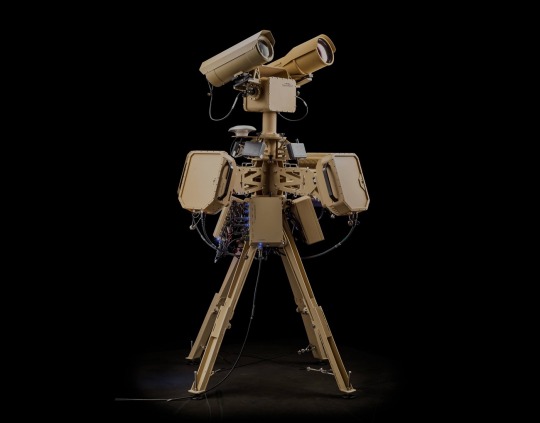
View On WordPress
0 notes
Text
Mobile Flugabwehr: Bundeswehr beschafft neue "Flak-Panzer"
Koblenz (ots) Mit der Beschaffung des Flugabwehrkanonenpanzers, kurz “Flak-Panzer”, des Typs Skyranger 30 schließt die Bundeswehr eine Fähigkeitslücke im Bereich der mobilen Abwehr unbemannter Luftfahrzeugsysteme (Counter-Unmanned Aircraft System, C-UAS). Ein entsprechender Vertrag wurde heute im Beschaffungsamt der Bundeswehr mit der Firma Rheinmetall Electronics GmbH unterzeichnet. In der…
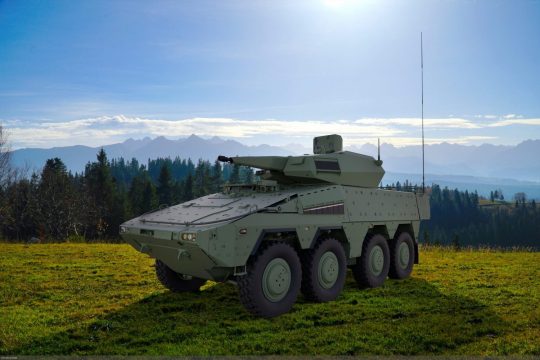
View On WordPress
0 notes
Text
Thermal Imaging Market Insights & Size Analysis 2025
Meticulous Research®—a leading global market research company, published a research report titled, ‘Thermal Imaging Market by Type (Handheld Cameras, Fixed Cameras, Scopes, Modules), Technology (Cooled, Uncooled), Wavelength (SWIR, MWIR, LWIR), Application (Security & Surveillance) - Global Forecast to 2032’
According to the latest publication from Meticulous Research®, the thermal imaging market is expected to reach $7.8 billion by 2032, at a CAGR of 7.2% from 2025 to 2032. This market’s growth is attributed to several factors, such as the growing need for surveillance & security solutions and the increasing utilization of thermal imaging in manufacturing and industrial settings. Additionally, the surge in demand for thermal imaging in healthcare, growing military & defense expenditure in advanced surveillance technologies, and rising unmanned aerial vehicles (UAVs) are expected to create market growth opportunities. However, the availability of alternative imaging technologies, such as visible light cameras & radar systems, may restrain the growth of this market.
On the other hand, the high cost of thermal imaging devices is a major challenge for the players operating in this market.
The global thermal imaging market is segmented by type, technology, wavelength, and application. This study also evaluates end-user industry competitors and analyzes the market at the region/country level.
Based on type, the thermal imaging market is broadly segmented into handheld/portable cameras, fixed/mounted cameras, scopes & eyewear, and modules. In 2025, the portable or handheld cameras segment is expected to account for the largest share, over 55.0%. This segment's large market share is attributed to its features, such as ease of use and portability, and the growing use of portable or handheld cameras for field inspection & maintenance and emergency and rescue operations.
However, the fixed/mounted cameras segment is expected to register the highest CAGR during the forecast period. This segment’s growth is driven by its ability to provide continuous, high-precision, real-time monitoring of critical infrastructure without the need for manual intervention, to withstand harsh environmental conditions, and its increasing demand for fixed thermal cameras for integrating with automated security and monitoring systems.
Based on technology, the thermal imaging market is segmented into cooled thermal imaging and uncooled thermal imaging. In 2025, the cooled thermal imaging segment is expected to account for a larger share of over 64.0% of the thermal imaging market. This segment’s large market share is due to its sensitivity, high accuracy, long-range detection, and image resolution, which allows for the detection of minute temperature differences and the capture of detailed thermal images and increasing use of cooled thermal imaging for extreme environmental conditions, such as high-temperature industrial environments or cold regions.
However, the uncooled thermal imaging segment is expected to register the highest CAGR during the forecast period. This segment’s growth is driven by its features, including cost-effectiveness, ease of maintenance, reduced operational costs, and growing demand for uncooled thermal imaging products in applications such as building diagnostics, wildlife monitoring, emergency response, law enforcement, and temporary monitoring needs in various scenarios.
Based on wavelength, the thermal imaging market is segmented into shortwave infrared (SWIR), mid-wave infrared (MWIR), and longwave infrared (LWIR). In 2025, the LWIR segment is expected to account for the largest share of over 49.0% of the thermal imaging market. The growing use of LWIR cameras in environmental monitoring, advanced driver assistance systems (ADAS), security and surveillance, and the need to detect thermal radiation emitted by objects across various industries are the main causes of this segment's large market share. Other factors include the segment's ability to provide non-contact temperature measurement for monitoring high-temperature processes and equipment, and its cost-effectiveness in comparison to MWIR and SWIR systems.
However, the SWIR segment is expected to register the highest CAGR during the forecast period. This growth is driven by its superior image contrast and detail, enhanced capability to ensure clear visibility in challenging environmental conditions, including smoke, fog, and haze, and growing demand for SWIR technology in medical diagnostics for non-invasive imaging.
Based on application, the thermal imaging market is segmented into aerospace & defense, security & surveillance, building & construction, personal vision systems, healthcare & medical diagnostics, energy & utilities, agriculture, research & development, search & rescue operations, marine systems, and other applications. In 2025, the security & surveillance segment is expected to account for the largest share of over 41.0% of the thermal imaging market. The growing need for improved surveillance capabilities, such as visibility in low light and obscured conditions, the growing use of thermal imaging to improve perimeter security for securing sensitive facilities and high-profile events, and the growing integration of thermal cameras into smart security systems to the overall effectiveness of security measures are all factors contributing to this segment's large market share.
However, the healthcare & medical diagnostics segment is expected to register the highest CAGR during the forecast period. This growth is being driven by an increase in demand for thermal imaging technology owing to its non-invasive nature for early disease detection by identifying abnormal heat patterns associated with conditions such as breast cancer, vascular disorders, and inflammation, and an increase in the use of thermal imaging for fever screening in public areas and in veterinary medicine to diagnose and monitor health conditions in animals.
Based on geography, the thermal imaging market is segmented into North America, Europe, Asia-Pacific, Latin America, and the Middle East & Africa. In 2025, North America is expected to account for the largest share of over 36.0% of the thermal imaging market.
North America's significant market share can be attributed to several key factors, including rising concerns over terrorism, crime, and public safety, increasing deployment of thermal imaging in large-scale surveillance applications such as city-wide monitoring or border control, increasing technological advancements in thermal imaging, high investments in advanced technologies for military and defense applications, and growing focus on advancing medical tools for non-invasive diagnostics and early disease detection.
Moreover, Asia-Pacific is expected to register the highest CAGR of over 8.5% during the forecast period.
Key Players:
The key players operating in the thermal imaging market are Teledyne FLIR LLC (U.S.) (a subsidiary of Teledyne Technologies Incorporated (U.S.)), Fluke Corporation (U.S.), L3Harris Technologies, Inc. (U.S.), Leonardo S.p.A. (Italy), Axis Communications AB (Sweden), BAE Systems plc (U.K.), RTX Corporation (U.S.), Lockheed Martin Corporation (U.S.), Testo SE & Co. KGaA (Germany), Thales Group (France), Seek Thermal, Inc. (U.S.), Exosens (France), Honeywell International Inc. (U.S.), Trijicon, Inc. (U.S.), Cantronic Systems, Inc. (U.S.), Safran Group (France), Zhejiang Dali Technology Co., Ltd. (China), HT Italia S.r.l. (Italy), Thermoteknix Systems Ltd. (U.K.), and Bullard (U.S.).
Download Sample Report Here @ https://www.meticulousresearch.com/download-sample-report/cp_id=5978
Key questions answered in the report-
Which are the high-growth market segments based on type, technology, wavelength, application, and geography?
What was the historical market for the thermal imaging market?
What are the market forecasts and estimates for the period 2025–2032?
What are the major drivers, restraints, opportunities, and challenges in the thermal imaging market?
Who are the major players, and what shares do they hold in the thermal imaging market?
What is the competitive landscape in the thermal imaging market?
What are the recent developments in the thermal imaging market?
What do the major players adopt the different strategies in the thermal imaging market?
What are the key geographic trends, and which are the high-growth countries?
Who are the local emerging players in the global thermal imaging market, and how do they compete with the other players?
Contact Us: Meticulous Research® Email- [email protected] Contact Sales- +1-646-781-8004 Connect with us on LinkedIn- https://www.linkedin.com/company/meticulous-research
Meticulous Research®—a leading global market research company, published a research report titled, ‘Thermal Imaging Market by Type (Handheld Cameras, Fixed Cameras, Scopes, Modules), Technology (Cooled, Uncooled), Wavelength (SWIR, MWIR, LWIR), Application (Security & Surveillance) - Global Forecast to 2032’
According to the latest publication from Meticulous Research®, the thermal imaging market is expected to reach $7.8 billion by 2032, at a CAGR of 7.2% from 2025 to 2032. This market’s growth is attributed to several factors, such as the growing need for surveillance & security solutions and the increasing utilization of thermal imaging in manufacturing and industrial settings. Additionally, the surge in demand for thermal imaging in healthcare, growing military & defense expenditure in advanced surveillance technologies, and rising unmanned aerial vehicles (UAVs) are expected to create market growth opportunities. However, the availability of alternative imaging technologies, such as visible light cameras & radar systems, may restrain the growth of this market.
On the other hand, the high cost of thermal imaging devices is a major challenge for the players operating in this market.
The global thermal imaging market is segmented by type, technology, wavelength, and application. This study also evaluates end-user industry competitors and analyzes the market at the region/country level.
Based on type, the thermal imaging market is broadly segmented into handheld/portable cameras, fixed/mounted cameras, scopes & eyewear, and modules. In 2025, the portable or handheld cameras segment is expected to account for the largest share, over 55.0%. This segment's large market share is attributed to its features, such as ease of use and portability, and the growing use of portable or handheld cameras for field inspection & maintenance and emergency and rescue operations.
However, the fixed/mounted cameras segment is expected to register the highest CAGR during the forecast period. This segment’s growth is driven by its ability to provide continuous, high-precision, real-time monitoring of critical infrastructure without the need for manual intervention, to withstand harsh environmental conditions, and its increasing demand for fixed thermal cameras for integrating with automated security and monitoring systems.
Based on technology, the thermal imaging market is segmented into cooled thermal imaging and uncooled thermal imaging. In 2025, the cooled thermal imaging segment is expected to account for a larger share of over 64.0% of the thermal imaging market. This segment’s large market share is due to its sensitivity, high accuracy, long-range detection, and image resolution, which allows for the detection of minute temperature differences and the capture of detailed thermal images and increasing use of cooled thermal imaging for extreme environmental conditions, such as high-temperature industrial environments or cold regions.
However, the uncooled thermal imaging segment is expected to register the highest CAGR during the forecast period. This segment’s growth is driven by its features, including cost-effectiveness, ease of maintenance, reduced operational costs, and growing demand for uncooled thermal imaging products in applications such as building diagnostics, wildlife monitoring, emergency response, law enforcement, and temporary monitoring needs in various scenarios.
Based on wavelength, the thermal imaging market is segmented into shortwave infrared (SWIR), mid-wave infrared (MWIR), and longwave infrared (LWIR). In 2025, the LWIR segment is expected to account for the largest share of over 49.0% of the thermal imaging market. The growing use of LWIR cameras in environmental monitoring, advanced driver assistance systems (ADAS), security and surveillance, and the need to detect thermal radiation emitted by objects across various industries are the main causes of this segment's large market share. Other factors include the segment's ability to provide non-contact temperature measurement for monitoring high-temperature processes and equipment, and its cost-effectiveness in comparison to MWIR and SWIR systems.
However, the SWIR segment is expected to register the highest CAGR during the forecast period. This growth is driven by its superior image contrast and detail, enhanced capability to ensure clear visibility in challenging environmental conditions, including smoke, fog, and haze, and growing demand for SWIR technology in medical diagnostics for non-invasive imaging.
Based on application, the thermal imaging market is segmented into aerospace & defense, security & surveillance, building & construction, personal vision systems, healthcare & medical diagnostics, energy & utilities, agriculture, research & development, search & rescue operations, marine systems, and other applications. In 2025, the security & surveillance segment is expected to account for the largest share of over 41.0% of the thermal imaging market. The growing need for improved surveillance capabilities, such as visibility in low light and obscured conditions, the growing use of thermal imaging to improve perimeter security for securing sensitive facilities and high-profile events, and the growing integration of thermal cameras into smart security systems to the overall effectiveness of security measures are all factors contributing to this segment's large market share.
However, the healthcare & medical diagnostics segment is expected to register the highest CAGR during the forecast period. This growth is being driven by an increase in demand for thermal imaging technology owing to its non-invasive nature for early disease detection by identifying abnormal heat patterns associated with conditions such as breast cancer, vascular disorders, and inflammation, and an increase in the use of thermal imaging for fever screening in public areas and in veterinary medicine to diagnose and monitor health conditions in animals.
Based on geography, the thermal imaging market is segmented into North America, Europe, Asia-Pacific, Latin America, and the Middle East & Africa. In 2025, North America is expected to account for the largest share of over 36.0% of the thermal imaging market.
North America's significant market share can be attributed to several key factors, including rising concerns over terrorism, crime, and public safety, increasing deployment of thermal imaging in large-scale surveillance applications such as city-wide monitoring or border control, increasing technological advancements in thermal imaging, high investments in advanced technologies for military and defense applications, and growing focus on advancing medical tools for non-invasive diagnostics and early disease detection.
Moreover, Asia-Pacific is expected to register the highest CAGR of over 8.5% during the forecast period.
Key Players:
The key players operating in the thermal imaging market are Teledyne FLIR LLC (U.S.) (a subsidiary of Teledyne Technologies Incorporated (U.S.)), Fluke Corporation (U.S.), L3Harris Technologies, Inc. (U.S.), Leonardo S.p.A. (Italy), Axis Communications AB (Sweden), BAE Systems plc (U.K.), RTX Corporation (U.S.), Lockheed Martin Corporation (U.S.), Testo SE & Co. KGaA (Germany), Thales Group (France), Seek Thermal, Inc. (U.S.), Exosens (France), Honeywell International Inc. (U.S.), Trijicon, Inc. (U.S.), Cantronic Systems, Inc. (U.S.), Safran Group (France), Zhejiang Dali Technology Co., Ltd. (China), HT Italia S.r.l. (Italy), Thermoteknix Systems Ltd. (U.K.), and Bullard (U.S.).
Download Sample Report Here @ https://www.meticulousresearch.com/download-sample-report/cp_id=5978
Key questions answered in the report-
Which are the high-growth market segments based on type, technology, wavelength, application, and geography?
What was the historical market for the thermal imaging market?
What are the market forecasts and estimates for the period 2025–2032?
What are the major drivers, restraints, opportunities, and challenges in the thermal imaging market?
Who are the major players, and what shares do they hold in the thermal imaging market?
What is the competitive landscape in the thermal imaging market?
What are the recent developments in the thermal imaging market?
What do the major players adopt the different strategies in the thermal imaging market?
What are the key geographic trends, and which are the high-growth countries?
Who are the local emerging players in the global thermal imaging market, and how do they compete with the other players?
Contact Us: Meticulous Research® Email- [email protected] Contact Sales- +1-646-781-8004 Connect with us on LinkedIn- https://www.linkedin.com/company/meticulous-research
#Thermal Imaging Market#Thermal Image#Night Vision#Thermogram#Security & Surveillance#Monitoring & Inspection#Fire Fighting#Personal Vision Systems#Vehicle Targeting#Counter-Unmanned Aircraft Systems (C-UAS)#Maritime & Coastal Surveillance#Search & Rescue Operation#Space Exploration Thermal Mapping#Handheld/Portable Cameras#Fixed/Mounted Cameras#Thermal Scopes#Military Targeting Systems#Perimeter Surveillance
0 notes
Text
Global Counter Drone Market report
Drones may carry a very wide variety of payloads, from a few grams to several kilograms. Over the past few years, more small drones have been used for a wider range of functions. Drones are simultaneously becoming a bigger menace to privacy, public safety, and civilization. An attacker can use drones to reach any target in any place without endangering troops, and they have an ever-expanding range of applications, from weapon transporters to espionage equipment. Counter-drone technology for the detection, deterrent, and destruction of incoming drone threats must be developed and implemented in order to mitigate and eventually eradicate the impact of drones.
Counter-UAS, or C-UAS, also known as counter-drone (anti-drone) technology, refers to devices that are able to identify and/or intercept unmanned aircraft systems (UAS) while they are in flight. As drone usage rises, defense unmanned aerial system (UAS) counter technology is always changing. Concerns about the threat that drones offer in both military and civilian situations have led to advancements in C-UAS technology.
Key drivers propelling the growth of the counter drone market:
Drone detection and drone mitigation or interception are the two categories of anti-UAS solutions, according to a market analysis of the Global counter drone Market report technologies. Drones are located using a variety of drone-detecting techniques, including PTZ cameras, RF sensors, and radar. Drone detection will detect drones flying inside a protected area's border.
The escalating defense budget and the ensuing rise in military procurement are anticipated to be among the primary factors influencing the counter-drone systems market's expansion. Given that the majority of economies have made significant investments in attack drones, counter-drone systems are a crucial piece of military hardware that increases both the survivability of soldiers and the armed forces.
Factors affecting the size of the counter-drone market:
The most popular technology for detecting drones are RF and radar detection. Radar and RF detection can be used in a variety of situations, including as crowded and noisy areas, to improve airspace security. When RF and radar are used together, a multi-layered system that provides users with better coverage and protection can be built.
Market Forecast & Dynamics for Counter-Drones:
Numerous military and commercial applications already make use of counter-drone technologies. The United States military uses C-UAS systems to defend its bases abroad. Additionally becoming more and more common is the deployment of mobile and portable systems to safeguard ground units and convoys. Numerous applications of counter-drone technology are currently in place in the civilian world. In the US, C-UAS are used to safeguard airspace at airports, stadiums, jails, businesses, and major events like the Super Bowl.
Analysis of the Counter-Drone Market for Recent Advancements:
Near the Red Fort region, a counter-drone technology developed by the Indian Defence Research and Development Organisation (DRDO) has been put in place to handle any potential drone or kite threats. This technology was designed to prevent dangers posed by unidentified aerial vehicles and aerial platforms. According to DRDO officials, the technology can find and deactivate drones of any size within a 4 km range. Additionally, the technology has the potential to advance the goal of domestic technological development, which will accelerate the expansion of local sourcing.
#Global Counter Drone Market report#Global Counter Drone Market#Global Counter Drone Market forecast#Counter Drone Market#Counter Drone Market report#Counter Drone Market forecast
0 notes
Text
U.S. Army Announces Release of DoD Counter-Small UAS Strategy
#USArmy announces release of DoD Counter-Small Unmanned Aircraft Systems (C-sUAS) Strategy.
The U.S. Department of Defense leadership recently approved a new strategy to lead and direct Counter-Small Unmanned Aircraft Systems (C-sUAS) activities across the Department. This strategy will provide the framework for addressing sUAS hazards and threats in a variety of operating environments, including the U.S. homeland, host nations, and contingency locations. Adversary UAS represent a…

View On WordPress
#C-sUAS#Counter-unmanned aerial system (C-UAS)#Pentagon (U.S. DoD)#Small Unmanned Aircraft System (sUAS)#U.S. Army
0 notes
Text
DroneShield counter-unmanned aircraft system products head to Australia, Brazil

[Image description: counter-unmanned aircraft system drones.]
Counter-unmanned aircraft system (C-UAS) company DroneShield has sold its RfOne MKII long-range sensors to the Australian Army. The capability is being delivered immediately to allow the Australian Army to assess its future counter-drone requirements and options, the company said.
DroneShield also has received formal approval from Anatel, the Brazilian National Telecommunications Agency responsible for issuing the concession of new radio frequencies. Following approval earlier this month, the company has sold a quantity of its DroneGun Tactical units to the Brazilian government.
“Brazil is a large and sophisticated market for military and security equipment, and we are pleased to commence active presence in the country, deploying equipment to the customers,” Vornik said. “We look forward growing our presence in Brazil with the urgent counter-drone requirements mirroring what we are seeing in other countries.”
Continue reading.
2 notes
·
View notes
Text

Santiago de Cali July 23 2025. Oscar Fredy Posso Vitali. Today More News.
Autónomous Drones Take Flight at NATO - Backed Competition.
From 6 to 10 July Four Teams of Seven Researchers and Profesors of Universities in The Netherlands, United States and Austria Challenged Each Other as the Huntsville UAS Unmaned Aircraft System and C-UAS Counter UAS Test Range in Alabama as Part of Competition Supported by the NATO Science for Peace and Security Programme.
Security Council Live: Debate on The Situation in The Middle East. The Security Council Meets Today in Quarterly Open Debate About Situation Middle East Focussed in Worsening Crisis in Gaza, Ravaged Enclave Where Food Entry and Distribution Remain Severely Restricted, Malnutrition Rising, While Fuel and Shelter Supplies Critically Scarce.
World Court Issues Advisory Opinión on Climate Change. The International Court of Justice ICJ in The Hague, Issued Advisory Opinión on Obligations of States in Respect of Climate Change, Readout by the Chair Court, Judge Iwasawa Yuji Today.
Colombian Govern Will Install Institutional Table With Congress and High Courts About New Rule Submmit.
Petro's Government Analyzes Exit Some Ministers. The Ministers Health, Environment and Equality. Man Falldown on Soil Since 11th Floor Building in Barranquilla.
Plane in Italy Crashing Against a Roadway: Two Deaths. USA Warns Half Percent Recuts Budget for Colombia in 2026. The Pope Leo Thinking in His Return at Vatican After Vacations in Castelgandolfo. Russia and Ukraine Retake Peace Negotiations in Istambul City of Turkey. Trump Announces Japan Trade Deal 15 Percent Tariffs. 38 People Hunger Dying in Gaza. Irán Fully Ready to Strike Israel Again and Not Detain Uranium Enrichment. More Than 100 ONG Warning Massive Famine in Gaza. Donald Trump Acussing Barack Obama by Trying Coup. Pope Leo: No Needful Luxuries to Buy, is Needful a Willing Heart to Make God's Volition.
0 notes